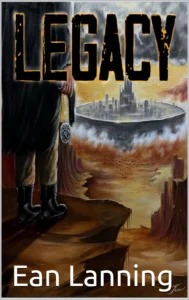Legacy by Ean Lanning

Manhattan lives with his guardian Tom in the crumbling ruins of Old Los Angeles. His clothes he wears, the boots on his feet, and a necklace he must protect are his only possessions. In a run-down house on the edge of the city, Manhattan and Tom have distance themselves from the chaos.
Meanwhile, Tom has sheltered Manhattan from the reality all around him. The guards who are supposed to protect the people are abusive and hostile.
The people are forced to live day by day on nothing more than scraps of burnt bread. Soon enough things begin to change.
And when a routine trip to the market ends in tragedy, Manhattan is left with a choice: join the Renegades in their fight to bring hope back to the city or leave his destiny and everyone behind.
Legacy Review
I was compensated for my time reading the book and writing this review. However, all thoughts and opinions expressed are my own and are based on my honest personal experience reading the book. Nor did the author in any way shape or form ever pressure me to give a positive review.
Legacy is a story set in a dystopian version of Los Angeles, where the city is divided into Old Los Angeles, a place in ruins, and New Los Angeles, a luxurious realm controlled by the tyrannical Lord Maddus.
Manhattan, our protagonist, lives in the desolate Old Los Angeles under the care of his guardian, Tom. The people of Old Los Angeles live under the oppressive regime and its ruthless guards.
However, an unexpected event forces Manhattan to make a choice: join the Renegades, a group of freedom fighters determined to overthrow Lord Maddus and bring hope back to the city, or leave behind his destiny and everything he knows.
The novel explores Manhattan’s journey as he joins the Renegades, growing out of his shell, and uncovers hidden secrets, all while vowing to end Lord Maddus’s rule over Los Angeles, no matter the cost.
Much like several other post-apocalyptic novels I’ve explored, Legacy astutely incorporates a world where societal inequalities persist, dictating the varying standards of living based on one’s social standing. Even in the face of impending global catastrophe, the wealth gap and the privileged status of the top 1% endure, while the remaining 99% bear the brunt of their heedlessness, underscoring a sobering and persistent reality.
Manhattan’s journey takes a pivotal turn when an ‘incident’ in the marketplace forces him to become a part of the revolutionary group Renegades. It’s at this point that the main story of the book begins, and as readers, we step into Manhattan’s shoes to delve into the intricate layers of this world.
I appreciate the depths and layers within the Renegades’ dynamics. The tension arising from the inherent lack of trust, particularly with Manhattan feeling understandably uninformed, adds a layer of realism to the group’s existence. It’s entirely plausible that an organization like the Renegades, operating under immense pressure and pursuing ambitious goals, would contend with internal discord among its members. This portrayal of internal conflict is a testament to the story’s authenticity and its reflection of the complexities one might encounter in real-life scenarios.
Nevertheless, the quality of the writing leaves something to be desired. While I commend the author’s commitment to detail, there are moments when the phrasing of descriptions feels somewhat repetitive and, at times, reads more like a report than an immersive narrative designed to vividly paint a mental picture for readers. This becomes evident right from the beginning when describing Tom, as seen from the following quote:
Tom was a tall man with broad shoulders and tan skin. He wore these worn-out black boots, ripped pants, and a tight blood-stained white shirt. He had shoulder length black hair with shades of gray, always tangled and always a mess. His face was one that did well hidden.
On the slim occasions he did show his face-mostly to get his point across when I didn’t listen-the hairs on the back of my neck shot up and my legs quivered in despair. Long disfigured scars bulged out from over his eyebrow, part of his lips, as well as his cheeks.
His nose was crooked and looked as if there were pieces of meat missing. But the biggest reason he covered up his face was his bad eye. A white eyeless marble replaced his eye.
In this 125-word paragraph alone, the words ‘he’ or ‘his’ appear ten times, constituting a whopping 8% of the total word count within this four-sentence paragraph alone. While this might seem like just one example, I’ve selected it to illustrate the widespread issue of repetition that appears in the book’s writing style as a whole.
When it comes to character development, the evolution of Manhattan is to be commended and is one of the strongest features in Legacy. His journey from an ordinary young boy to a courageous individual willing to take risks when needed is both realistic and believable, making me invested in his progression in the story. Manhattan’s motivation for seeking revenge because of Tom’s fate is particularly well-executed as a source of motivation for his growth and behaviour when driving the plot’s progression.
Maddus, the story’s primary antagonist, leaves an indelible impression as an unapologetically wicked character. His portrayal seems to symbolize the unbridled malevolence often associated with the wealthiest echelons of our real-world society. Maddus epitomizes those who, in their pursuit of maintaining their status, spare no cruelty and misuse their powers, influence, and resources to the detriment of others and the greater good.
The plot stands out as another one of the Legacy’s strong suits. Its well-executed pacing allows the story to unfold smoothly, maintaining a logical and coherent narrative throughout. Furthermore, the underlying concept of the book is undeniably commendable.
However, it’s undeniable that the lacklustre writing quality significantly dampens my enthusiasm while reading the book. I believe that if the author were to invest resources in proofreaders and seek additional input during the editing process to address the issues of repetition and awkward phrasing, this book could evolve into a compelling post-apocalyptic dystopian novel with a solid story.
To conclude this review on a brighter note, a fun thing with Legacy for me is that if I were to get a nickel every time I read a post-apocalyptic ARC book that is connected in Manhattan in some way, I’d have like two. Which is not a lot but still kind of weird that it happened twice haha. The other book I reviewed was set in a futuristic dystopian setting of Manhattan, and in Legacy, the protagonist’s name is Manhattan but based in Los Angeles. Just kind of hilarious.
If you liked this review and want to see other book reviews like this one, check out my book reviews collection!

